e would like to extend a solution
 of the equation (
First order PDE
) from a
surface of boundary condition along some family of
curves
of the equation (
First order PDE
) from a
surface of boundary condition along some family of
curves
 We seek an effective way to define such a family. We hope to reduce the non
linear PDE (
First order PDE
) to a system of
ODEs.
We seek an effective way to define such a family. We hope to reduce the non
linear PDE (
First order PDE
) to a system of
ODEs.
Notation
We introduce the
notations


We differentiate the definition (*) along the parameter
 :
:
 We also differentiate the (
First order PDE
)
along
We also differentiate the (
First order PDE
)
along
 for every
for every
 :
:
 We would like to get rid of the derivative
We would like to get rid of the derivative
 ,
hence, we differentiate the definition (**) of
,
hence, we differentiate the definition (**) of
 with respect to
with respect to
 :
:
 Therefore, if we would
require
Therefore, if we would
require
 we would easily remove the
we would easily remove the
 from
(***):
from
(***):
 We collect our results as follows.
We collect our results as follows.
Definition
The functions
 that satisfy the system of
ODE
that satisfy the system of
ODE
 are called characteristics of the PDE (
First order
PDE
).
are called characteristics of the PDE (
First order
PDE
).
If a function
 solves the PDE and
solves the PDE and
 solves (c) with
solves (c) with
 and
and
 then p and z solve (a) and (b). One may always attempt to go in reverse:
extend a solution of PDE from some (consistent) boundary condition using a
family of solutions of (a),(b),(c).
then p and z solve (a) and (b). One may always attempt to go in reverse:
extend a solution of PDE from some (consistent) boundary condition using a
family of solutions of (a),(b),(c).
|